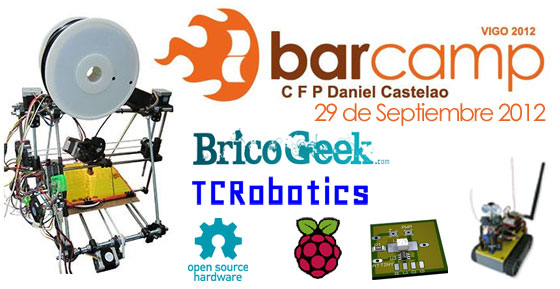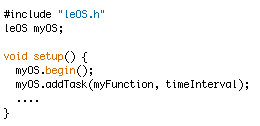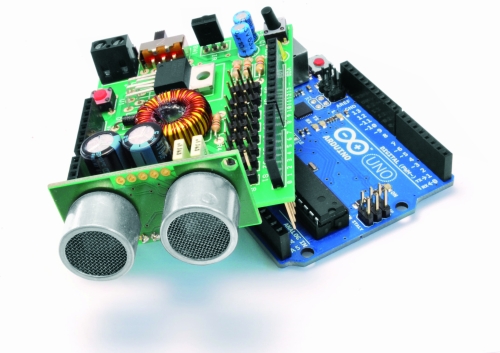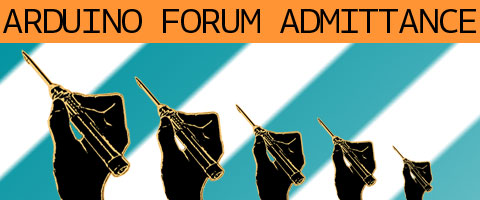MIDI WITH ARDUINO
– September 10th, 2012
We have already mentioned the fantastic work of Amanda Ghassei for Instructables in this post.
I would like to report two other very useful documents.
I would like to report two other very useful documents.

The first is What is MIDI? and explain in detail how MIDI protocol works. The second, even more important is Send and Receive MIDI with Arduino. Please note, regarding the Midi input schematic, the use of the 6N138 opto-isolator. Some MIDI interface schematics show the 4N25 opto-isolator which is a single transistor type, but the 6N138 shown there produces a much better output signal.
Via:[Instructables]
HELP BRING MAKER CULTURE AND HACKER SPACES TO IRAQ.
– September 9th, 2012
A friend of mine is doing a KickStarter project to run a livestream conference and a temporary hackerspace in Baghad this fall. Bilal Ghalib (of GEMSI) has been working to bring maker culture and hacker spaces to the Middle East, for example by organizing a temporary maker space at the Maker Faire Cairo in 2011.
Here are some details of the workshops they’re organizing:
- Riwaya wa Bidaya (Oct 5): A livestream conference to share stories of everyday superheroes in Baghdad who take initiative to solve problems. We are inviting submissions until Sept 22 [apply here!] – top stories will be illustrated by a professional graphic comic book artist and published in Arabic and English.
- ‘Amal wa Amal (Oct 18-19): In collaboration with TEDxBaghdad, we are setting up a temporary community hackerspace to share local tools and solutions. We hope this will provide an inspiration for an ongoing community and hackerspace to develop in Baghdad.
Please help support the KickStarter project.
A SIMPLE ARDUINO-BASED TACHOMETER
– September 6th, 2012

Chris, from PyroElectro.com, proposes a comprehensive tutorial on how to make a simple, yet effective, Arduino-based tachometer.
The circuit is very simple: an IR led is coupled with an IR phototransistor to detect possible interruptions of the light beam, while the Arduino is responsible to calculate the time interval between two such events. Finally, a LCD is used to display the current RPM to the user.
To validate his project, a typical computer fan has been used in the set-up and the outcomes have demonstrated to be very close to the true RPM value (2600 +/- 100 RPMs).
The bill of materials, as well as the schematic, the source code and a detailed tutorial on how to build the circuit is available here.
[Via: PyroElectro.com]
CASTELAO BARCAMP VIGO 2012
– September 5th, 2012

Desde BricoGeek nos llega la noticia de la celebración de una nueva Barcamp, esta vez en Vigo. La reunión perfecta para cacharrear y debatir entre amigos sobre temas como el Open Hardware, Arduino o impresoras 3D entre otros muchos, y puede que con alguna que otra sorpresa.
Unas jornadas DIY muy interesantes que tendrán lugar en las instalaciones delCFP Daniel Castelao de Vigo en las que Alejandro Taracido presentará a su mítico robot ORUGAS con las últimas novedades añadidas.
Sin duda, un evento al que no se debe faltar!
Planning preliminar (sujeto a cambios):
- Introducción al Open Harwdare
- Orugas: Robot explorador basado en Arduino
- Impresión 3D DIY. Crea objetos en tu casa
- Workshop BricoGeek
- Taller: DIY Soldadura SMD por refusión
- Taller: Medidas PWM analógicas
- Presentación proyecto RACE
- Raspberry PI como servidor FTP de contenidos
Enlaces:
VIA | BricoGeek
ARDUINO WORKSHOP A ROMA 29-30 SEPT 2012 [ARDUINO TOUR]
– August 31st, 2012
Ecco il primo di una serie di workshop che Officine Arduino organizzerà in Italia. Quale luogo migliore da cui iniziare se non la capitale? Abbiamo parlato / immaginato / organizzato con molte persone in questi mesi – da Trieste in giù – ed il buon Alex Giordano lo ha già ribattezzato come il “Tour di Arduino“. Ci accontentiamo di portare workshop dove non sono mai stati, e quindi al Sud, nelle isole. Vogliamo rispondere alle decine di mail di utenti che hanon chiesto e chiedono un workshop a casa loro.
Oggi ci accontentiamo di annunciare questo workshop, che non sarebbe stato possibile senza l’appoggio di Cattid- Centro di Ricerca sulla Comunicazione e la Tecnologia dell’Università la “Sapienza” di Roma e gli amici di DiScienza, una associazione italiana di cui abbiamo parlato spesso, organizzatori dell’annuale Arduino Day che si tiene ogni anno proprio a Roma.
Una talk pubblica su Arduino e l’Educazione, con la spiegazione di vari progetti e possibilità di fare domande e networking é prevista in venerdì 28 settembre in luogo da definirsi. Qualora foste interessati iscrivetevi qui.
Abbiamo anche cercato di venire incontro ad alcune problematiche che sorgono quando si organizzano eventi in giro. Cosa succede se non avvengono vicino a te? Proprio per questo lanciamo un servizio abbastanza rudimentale: un form in cui potete dire dove siete e noi, una volta raggiunto un certo numero di persone vi informiamo in anticipo sulle date e i posti.
Ovviamente non volevamo escludere gli utenti del vivace forum italiano, ai quali offriamo di partecipare gratuitamente alla parte di realizzazione dei progetti della domenica. Per ovvie ragioni abbiamo dovuto limitare il numero di fruitori di questo servizio (che testiamo proprio in questa occasione) al numero di 5 persone. E’ molto importante supportare piccole realtà (non tanto piccole nel caso di Roma, ovviamente) di Smanettoni Arduinici Urbani (i famosi SAU).
Dubbi, domande, perplessità? visitate la pagina del workshop o scrivete a d.gomba(at)arduino.cc
DIGITAL ARTIST JULIEN BAYLE [INTERVIEW]
– August 31st, 2012
Julien Bayle is a digital artist and technology developer, and his work is an excellent starting point for anyone interested in the DIY man-machine interfaces.
Back in 2008, Julien created a clone of the Monome, a control surface consisting in a matrix of leds and buttons whose functioning is defined by software. It was called Bonome and RGB leds were used, instead of monochromatic leds of the standard model. Here are the instructions to build it.
Some time later, inspired by the DIY controller used by Monolake, Julien decided to build its own Protodeck to control Ableton Live.
Recently I stumbled upon his post titled “Arduino is the Power” and I discovered that Julien has started writing a book about the Arduino platform. So I thought that regular readers of the Arduino Blog would welcome an interview with this interesting guy. And here it is!
Andrea Reali: Tell us something about you.
Julien Bayle: I’m Julien Bayle from France. I’m a digital artist and technology evangelist. I’m inside computers world since my dad bought us a Commodore 64, around 1982.
I’m working with music softwares since the first sound-trackers and I began to work with visuals too with my Amiga 500, using some first POV-like softwares.
I first began by working as an IT Security Architect by day, then I quit to be only what I am today and especially to be really free to continue my travel inside art & technology.
I’m providing courses & consulting & development around open-source technology like Arduino, java/processing but also & especially with Max6 graphical programming framework which is my speciality. Max6 is really an universe itself and we’d need more than one life to discover all features. As an Ableton Certified Trainer, I’m still teaching that a bit.
All technology always provides tools to achieve art. I guess my path comes from pure technology and goes to pure art.
I’m working with music softwares since the first sound-trackers and I began to work with visuals too with my Amiga 500, using some first POV-like softwares.
I first began by working as an IT Security Architect by day, then I quit to be only what I am today and especially to be really free to continue my travel inside art & technology.
I’m providing courses & consulting & development around open-source technology like Arduino, java/processing but also & especially with Max6 graphical programming framework which is my speciality. Max6 is really an universe itself and we’d need more than one life to discover all features. As an Ableton Certified Trainer, I’m still teaching that a bit.
All technology always provides tools to achieve art. I guess my path comes from pure technology and goes to pure art.
LEOS AND LOOPER: TASK SCHEDULING MADE EASY ON ARDUINO
– August 29th, 2012

In his website, Leonardo Miliani proposes a simple prototype of a pseudo operating system for Arduino, dubbed leOS (which is the acronym of little embedded operating system). Its goal is to provide the user with the capability to periodically schedule any given C function according to a specific time period. From his blog:
To be honest, it should more correct to say that leOS is actually something that is halfway a simple prototype of an real-time operating system (RTOS) and a scheduler. [...]leOS can run simple tasks that don’t require excessive CPU time but it can be useful in all of those situations where the user wants to let a task run itself out of the main loop.
Based on the experience pursued during the development of leOS, Leonardo also proposes another project, named looper, which resembles a simple task scheduler. Its goal is to provide a much lighter set of APIs for scheduling tasks on the microcontroller, if compared to leOS.
[Via: Leonardo Miliani's website]
THE ARDUINO WIFI SHIELD IS NOW AVAILABLE
– August 16th, 2012
The Arduino Wifi Shield is finally here!
We’ve been working for a while on this new wifi shield for Arduino that is quite different from what you can find already on the market.
Instead of just getting the usual pre-made module we decided to build a product that would encourage hacking and modifications so we decided to use an AVR32 processor running an open source version of TCP/IP and the WIFI software stack. The Arduino communicates over SPI with the AVR32 and this in turn controls the WIFI module, an HDG104 from H&D Wireless. Following the Arduino tradition the full software stack running on the AVR32 is released as open source as well as the Arduino library that controls the shield.
Having the full source for the software stack allows adding more complex protocols directly on the AVR32 without using the limited code space of the atmega328 on the Arduino. On top of this, skilled C developers can re-program the shield to operate as a standalone device without the need of an Arduino connected to it. Since we expect that there will be amazing new features created by the community we made updating its firmware very easy, just connect a usb cable to the shield. We believe this opens up to a lot of hacking potential.
Here are some of its features:
- Connection via: 802.11b/g networks
- Encryption types: WEP and WPA2 Persoanl
- Connection with Arduino on SPI port
- on-board micro SD slot
- ICSP headers
- FTDI connection for serial debugging of WiFi shield
- Mini-USB for updating WiFi shield firmware
- HDG104 Wireless LAN 802.11b/g System in-Package
- Atmega 32UC3 32bit microcontroller
- open source firmware.
For more details see the product page and on the wifi-shield on the Arduino Store.
We hope you will enjoy creating with the new member of the Arduino family.
ARDUINO AT TED GLOBAL: BACKSTAGE FOOTAGE
– August 7th, 2012
The good natured Arduino co-founder and his team went to talk at TED global and rocked the stage (Yes, old news!). But, here is some previously unseen backstage travelogue of Massimo Banzi and Federico Vanzati, shot through the lenses of Davide Gomba. Just having some fun before the serious talks!
AN OPEN ROBOT SHIELD FOR ARDUINO
– August 6th, 2012

Open Electronics‘ staff were looking for a common and standard hardware platform usable on different robots they were working on. Their goal was to find a single platform that had to provide power supply to the microcontroller, it had to provide stabilized voltage for the servos, and, finally, it had to be equipped with an obstacle detector and with an IR receiver.
Having chosen Arduino as the target core board, they developed an ad-hoc shield meeting all these requirements, whose detailed description can be foundhere, together with the BOM and a lot of source code.














0 comentarios:
Publicar un comentario